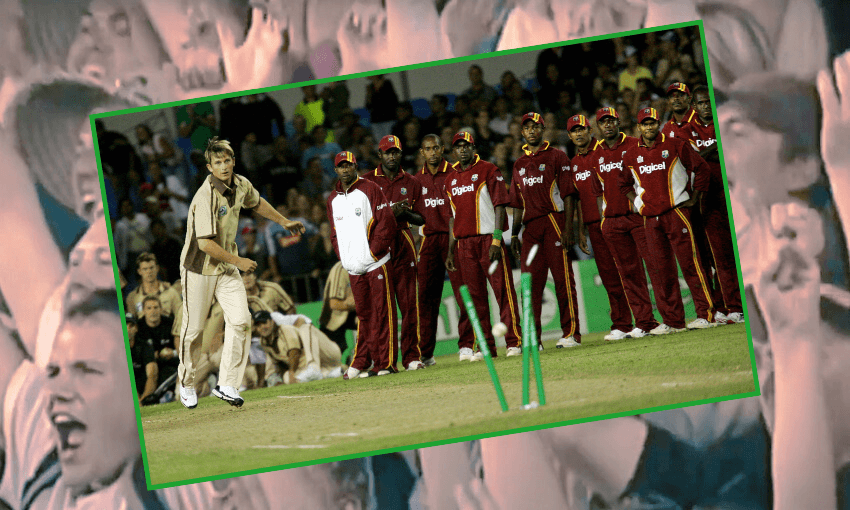We’re one of the only nations to experience this rare and thrilling tiebreak method, and have suffered more than anyone from its demise. Who better to bring it back?
Twenty years ago next month, the first ever T20 international was played between New Zealand and Australia at Eden Park. This milestone event in the history of cricket saw the Black Caps wear retro beige uniforms, grow novelty facial hair and select Jeff Wilson, and the match ended with Glenn McGrath being shown a red card by umpire Billy Bowden for threatening to bowl underarm in homage to Trevor Chappell.
Few who witnessed this spectacle would have predicted the extent to which the T20 format would dominate cricket in the years to come. Some of the new tactics and innovations it’s inspired would have made people’s heads fall off if they’d seen them that night at Eden Park. But for all cricket’s great leaps forward in the last 20 years, it’s also taken one major step back.
A year later, international T20 returned to Eden Park as New Zealand played the West Indies – still dressed in beige, but with fewer handlebar moustaches and a greater appreciation of the fact that T20 might be here to stay. Our first domestic T20 competition, a seven-match mini-tournament won by an insanely stacked Canterbury Wizards, had been contested earlier that summer. Jeff Wilson was out, Shane Bond was in.
The West Indies batted first and scraped together 126/7 from their 20 overs. Bond finished with the immaculate figures of 2/15, including the prized scalp of Chris Gayle. In response, the Black Caps batters struggled to 111/8 at the end of the 19th over, leaving Bond and James Franklin requiring 16 off the final over. A six from Franklin off the second ball brought that target within reach, but the pair could only manage singles off the next three balls, leaving Bond needing five to win off the final delivery. He heaved it over cover for four, and the scores were tied.
With the Super Over still a mere twinkle in the ICC’s eye, the match instead went to a bowl-out.
Like a football penalty or a basketball free throw, the bowl-out asks players to execute a simple action under a suffocating amount of pressure. All the bowler has to do is deliver a ball that hits the unguarded set of stumps at the other end of the wicket – something they should in theory be able to do consistently. In the nets they’d probably do it nine times out of 10, but as the brief history of the bowl-out shows, it’s a different story under the spotlight.
The rules of this particular bowl-out saw five bowlers from each team take turns bowling two deliveries each in a best-of-10 format. Nathan Astle stepped up first and reliably delivered two slow-medium deliveries on a good length. Both passed outside off stump. Dwayne Smith took the ball for the West Indies and sent two balls wide down leg. Jeetan Patel missed, then missed again. Chris Gayle did the same. Chris Cairns, in his final match for New Zealand, got nowhere near. Neither did Jerome Taylor.
After a staggering 12 deliveries had failed to hit the stumps, up stepped Shane Bond. Bowling at half-pace, his first delivery cannoned into middle and off, sending the crowd into raptures. His second delivery, a full toss, achieved the same result. Ian Bradshaw missed two more for the West Indies, leaving Scott Styris to coolly clinch a 3-0 bowl-out victory for the hosts.
It was a sublime and ridiculous bit of sporting theatre, only to be seen once again in international cricket, when India beat Pakistan by the same margin in a bowl-out at the inaugural T20 World Cup in 2007. “I won’t want to see [another] cricket match decided on a bowl-out,” winning captain MS Dhoni dourly told reporters after the match. “It should always be decided on the field.” The Super Over was introduced the following year.
If the bowl-out was cricket’s answer to penalties, a Super Over is more like extra time: each team faces another over each, and the team that scores the most runs in that over wins. Perhaps the most famous Super Over took place in a One Day International between New Zealand and England at Lord’s in 2019, a match which also happened to be the World Cup final.
Without wanting to reopen the wounds of that fateful day, these are the facts: at the end of 50 overs, the scores were tied. This forced a Super Over, at the end of which scores were still tied. At this point, the previously unheard of “boundary count back” was invoked, by which England were declared champions.
Following widespread outcry that this rule was a total load of shit, it was changed so that a tied Super Over simply results in another Super Over, like playing multiple overtimes in basketball. Most would say that this is fair and just, and they are right to a point: the Super Over is a good way to decide a winner, and should remain cricket’s primary tiebreaker. But the bowl-out still has a role to play.
In a football World Cup final, a tie after extra time would have resulted in a penalty shoot-out, one of the cruellest but also most thrilling ways of deciding a winner ever invented. This is what should happen in cricket, in the unlikely event of a tied Super Over.
Would New Zealand have won the World Cup if the final had gone to a bowl-out after the Super Over? Maybe not. Would it have been an even more agonising and fucked up way to lose than boundary count back? Probably! Would it have been a better way of deciding the final either way? Absolutely.
Super Overs are a relatively rare occurrence; bowl-outs would be rarer still, the cricketing equivalent of hitting the Powerball after winning Lotto’s first division. Even in this era of T20 abundance, we might only see one every few years – they’d be a genuine rarity, like a hat-trick, triple century or spectacular boundary catch used to be. The chance of a bowl-out would inject novelty back into a sport in which it’s become an increasingly scarce and valuable commodity.
There is also a practical side to the argument – this weekend’s Super Smash finals, for example, are being played as a double-header, with a tight turnaround between the women’s and men’s matches. More than one Super Over at the end of the first match would blow the schedule to pieces. A bowl-out is both the fun and sensible solution.
Sure, the two international bowl-outs to date have been total shitters – one-sided, low quality, bordering on farcical. But imagine a bowl-out version of football’s epic Matildas vs France penalty shoot-out. Imagine a wicketkeeper being forced to step up and bowl the decisive delivery with their pads still on. Imagine, if you’re some kind of high-powered cricket executive, the content this would generate – the engagement.
This year the Super Smash made a play for the attention of New Zealand’s cricket nostalgists by introducing 90s-inspired uniforms. Next season it should up the ante with another kind of retro throwback, and bring back the slim, thrilling possibility of a bowl-out.






